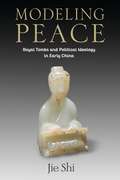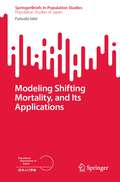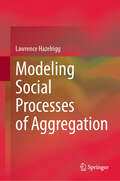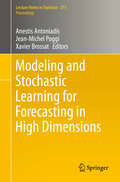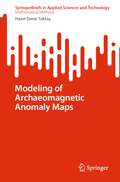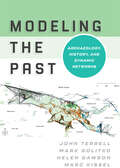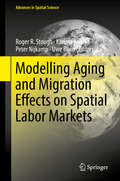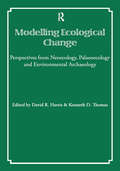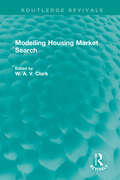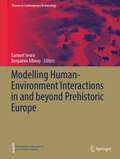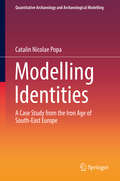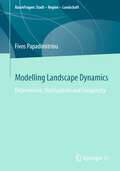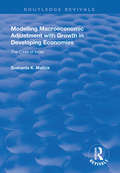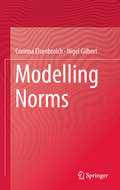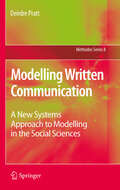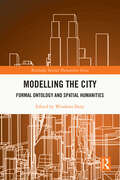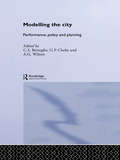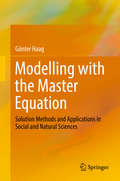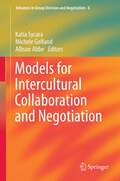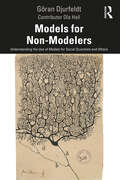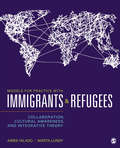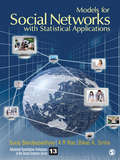- Table View
- List View
Modeling Peace: Royal Tombs and Political Ideology in Early China (Tang Center Series in Early China)
by Jie ShiAmong hundreds of thousands of ancient graves and tombs excavated to date in China, the Mancheng site stands out for its unparalleled complexity and richness. It features juxtaposed burials of the first king and queen of the Zhongshan kingdom (dated late second century BCE). The male tomb occupant, King Liu Sheng (d. 113 BCE), was sent by his father, Emperor Jing (r. 157–141 BCE), to rule the Zhongshan kingdom near the northern frontier of the Western Han Empire, neighboring the nomadic Xiongnu confederation.Modeling Peace interprets Western Han royal burial as a political ideology by closely reading the architecture and funerary content of this site and situating it in the historical context of imperialization in Western Han China. Through a study of both the archaeological materials and related received and excavated texts, Jie Shi demonstrates that the Mancheng site was planned and designed as a unity of religious, gender, and intercultural concerns. The site was built under the supervision of the future occupants of the royal tomb, who used these burials to assert their political ideology based on Huang-Lao and Confucian thought: a good ruler is one who pacifies himself, his family, and his country. This book is the first scholarly monograph on an undisturbed and fully excavated early Chinese royal burial site.
Modeling Shifting Mortality, and Its Applications (SpringerBriefs in Population Studies)
by Futoshi IshiiThis book describes a novel method for mortality modeling applying the shifting feature of the mortality curve. In Japan, the increase and pace of the extension in life expectancy have been quite remarkable. Therefore, existing mortality models often cannot capture the peculiarities of Japanese mortality, nor can the Lee–Carter model, which is now regarded internationally as a standard model. One of the important concepts to model recent Japanese mortality is a shifting feature. In this book, the linear difference model, which has many advantages for modeling and analyzing Japanese mortality, is introduced. The book shows applications of the model to mortality projection with a tangent vector field approach and decomposition of the change of modal age at death. The models introduced here are useful tools for modeling mortality with strong shifting features, as in Japan.
Modeling Social Processes of Aggregation
by Lawrence HazelriggThis book demonstrates, via formal statements and empirical illustrations, that nonlinearities in social processes can be modeled systematically to create solutions with practical applications in the institutional forms of paid employment, schooling, and familial relations including marital and kinship ties and the rearing of children. It shows how social processes can be modeled accurately through analyzing time series data—specifically, a temporal sequence of process outcomes that is dense enough in observation time to support appropriate techniques of modeling the outcome sequence. The book illustrates techniques using minimal mathematical formalism which is explained also in careful narrative descriptions of the model logic.
Modeling and Stochastic Learning for Forecasting in High Dimensions
by Jean-Michel Poggi Anestis Antoniadis Xavier BrossatThe chapters in this volume stress the need for advances in theoretical understanding to go hand-in-hand with the widespread practical application of forecasting in industry. Forecasting and time series prediction have enjoyed considerable attention over the last few decades, fostered by impressive advances in observational capabilities and measurement procedures. On June 5-7, 2013, an international Workshop on Industry Practices for Forecasting was held in Paris, France, organized and supported by the OSIRIS Department of Electricité de France Research and Development Division. In keeping with tradition, both theoretical statistical results and practical contributions on this active field of statistical research and on forecasting issues in a rapidly evolving industrial environment are presented. The volume reflects the broad spectrum of the conference, including 16 articles contributed by specialists in various areas. The material compiled is broad in scope and ranges from new findings on forecasting in industry and in time series, on nonparametric and functional methods and on on-line machine learning for forecasting, to the latest developments in tools for high dimension and complex data analysis.
Modeling of Archaeomagnetic Anomaly Maps (SpringerBriefs in Applied Sciences and Technology)
by Hazel Deniz ToktayThis book deals with magnetic anomaly maps and their properties. These properties are essential to modeling the elimination of the uncertainty problem of buried archaeological structure locations and depths. To this end, several models are presented and their quantitative properties are studied. Numerical simulations have been created, confirming theoretical results that were obtained.
Modeling the Past: Archaeology, History, and Dynamic Networks
by Mark Golitko Marc Kissel Helen Dawson John TerrellHow do researchers use dynamic network analysis (DYRA) to explore, model, and try to understand the complex global history of our species? Reduced to bare bones, network analysis is a way of understanding the world around us — a way called relational thinking — that is liberating but challenging. Using this handbook, researchers learn to develop historical and archaeological research questions anchored in DYRA. Undergraduate and graduate students, as well as professional historians and archaeologists can consult on issues that range from hypothesis-driven research to critiquing dominant historical narratives, especially those that have tended ignore the diversity of the archaeological record.
Modelling Aging and Migration Effects on Spatial Labor Markets (Advances in Spatial Science)
by Roger R. Stough Peter Nijkamp Karima Kourtit Uwe BlienThe aging and migration megatrends and their impact on spatial – regional and local – labor market performance is the core theme of this book, and thus together define its scope and focus. The contributions provide an overview of key aging and migration issues in various countries together with analyses of their varied impacts on regional labor markets. Systematic database research and related empirical analyses are used to map out the complex and dynamic nature of these trends, while cutting-edge economic and modeling techniques are used to analyze them. In closing, the book critically reviews and assesses selected policy measures designed to cope with the effects of aging and migration on regional labor markets.
Modelling Ecological Change: Perspectives from Neoecology, Palaeoecology and Environmental Archaeology (UCL Institute of Archaeology Publications)
by David R. Harris Kenneth D. ThomasA collection of papers connecting theory and method of archaeology with related disciplines of neoecology, paleoecology, and environmental science.
Modelling Housing Market Search (Routledge Revivals)
by W. A. V. ClarkOriginally published in 1982, this book contains research in the area of econometric modelling in the housing market, including that which has extended to the use of search models. The subjects covered include the importance of racial differences, spatial aspects of residential search and information provision and its effect on the behaviour of the buyers. The combination of careful analytic modelling, empirical testing and speculative discussions of the role of agents in the search process provides an innovative and imaginative approach to the interesting problems of understanding the individual behaviour in complex contexts such as the urban housing market.
Modelling Human-Environment Interactions in and beyond Prehistoric Europe (Themes in Contemporary Archaeology)
by Samuel Seuru Benjamin AlbouyThis book offers insight into the relationship between prehistoric and protohistoric human populations and the world around them. It reconstructs key aspects of the palaeoenvironment – from large-scale drivers of environmental conditions, such as climate, to more regional variables such as vegetation cover and faunal communities. The volume underscores how computational archaeology is leading the way in the study of past human-environment interactions across spatial and chronological scales. With the increased availability of high-resolution climate models, agent-based modelling, palaeoecological proxies and the mature use of Geographic Information System in ecological modelling, archaeologists working in interdisciplinary settings are well-positioned to explore the intersection of human systems and environmental affordances and constraints. These methodological advancements provide a better understanding of the role humans played in past ecosystems – both in terms of their impact upon the environment and, in return, the impact of environmental conditions on human systems. They may also allow us to infer past ecological knowledge and land-use patterns that are historically contingent, rather than environmentally determined. This volume gathers contributions that combine reconstructions of past environments and archeological data with a view to exploring their complex interactions at different scales and invites scholars from varying disciplines and backgrounds to present and compare different modelling approaches.
Modelling Identities: A Case Study From The Iron Age Of South-east Europe (Quantitative Archaeology And Archaeological Modelling Ser.)
by Catalin Nicolae PopaThis volume investigates the construction of group identity in Late La Tène South-East Europe using an innovative statistical modelling method. Death and burial theory underlies the potential of mortuary practices for identity research. The sample used for this volumes's research consists of 370 graves, organized in a specially crated database that records funerary ritual; and grave-good information. In the case of grave-goods, this involved found hierarchically organized categorical variables, which serve to describe each item by combining functional and typological features. The volume also aims to show the compatibility of archaeological theory and statistical modelling. The discussions from archaeological theory rarely find methodological implementations through statistical methods. In this volume, theoretical issues form an integrative part of data preparation, method development and result interpretation.
Modelling Landscape Dynamics: Determinism, Stochasticity and Complexity (RaumFragen: Stadt – Region – Landschaft)
by Fivos PapadimitriouThis book offers a comprehensive exposition of the mathematical methods that can be used to model landscape dynamics. It is systematically shown how mathematical models of progressively higher complexity can be derived from ordinary landscape maps and related data in ways that enable researchers to predict future landscape transformations and to assess landscape stability, sustainability and resilience.These models are deterministic (i.e. linear or non-linear systems of differential equations), stochastic (i.e. Markovian), or combined deterministic-and-stochastic (using stochastic differential equations), whereas topics and challenging problems related to complexity (spatial randomness, chaotic behaviors, riddled systems etc) are also examined in the book.
Modelling Macroeconomic Adjustment with Growth in Developing Economies: The Case of India (Routledge Revivals)
by Sushanta K. MallickFirst published in 1999, this influential volume explores Macroeconomic Adjustment with a particular focus on India. Its inspiration originated from the introduction of stabilisation and structural adjustment policies in India in 1991. Mallick examines the application of this policy package by the International Monetary Fund and the World Bank to Developing Economies. First looking at the initial conditions and generators of imbalances, the appropriate policy framework for India’s initial conditions and structural characteristics is considered. While the effectiveness of the IMF had been strongly criticised, Mallick explains how it could be used more effectively. He argues that the programs applied are often contradictory and, using India as an example, examines the effects of policy reform on its trade sector, the repercussions on the direct economy and the costs associated with such policies in restoring stability and future economic growth, with particular support for the Vector Autoregression (VAR) framework. Mallick forwards a new structural model for policy purposes, evaluated for overall performance and optimal control.
Modelling Norms
by Nigel Gilbert Corinna ElsenbroichThe book focusses on questions of individual and collective action, the emergence and dynamics of social norms and the feedback between individual behaviour and social phenomena. It discusses traditional modelling approaches to social norms and shows the usefulness of agent-based modelling for the study of these micro-macro interactions. Existing agent-based models of social norms are discussed and it is shown that so far too much priority has been given to parsimonious models and questions of the emergence of norms, with many aspects of social norms, such as norm-change, not being modelled. Juvenile delinquency, group radicalisation and moral decision making are used as case studies for agent-based models of collective action extending existing models by providing an embedding into social networks, social influence via argumentation and a causal action theory of moral decision making. The major contribution of the book is to highlight the multifaceted nature of the dynamics of social norms, consisting not only of emergence, and the importance of embedding of agent-based models into existing theory.
Modelling Written Communication
by Deirdre PrattThis book offers an alternative view to current postmodern approaches to composition. It takes a critical realist stance to arrive at the "essence" of written communication with the aim of informing a practical application: a computerised writing tutor. Following Robert Franck's seminal work on modelling, a theoretical model of writing was first formulated, consisting of an architecture of functions which constitute the prerequisites for effective communication. Next, an applied model - a composing algorithm with an input option - was developed, showing composing to be a systemic social process with intra- and extra-systemic variation. The algorithm provided the design template for a writing tutor program which models for the learner both the systemic and the socially situated nature of writing. This book establishes composing as a communicative interaction, and shows the essential dynamism of writing, while offering an exemplar of a systems approach to modelling in the social sciences.
Modelling the City: Formal Ontology and Spatial Humanities (Routledge Spatial Humanities Series)
by Wiesława DużyModelling the City focuses on European towns and cities, analysing the opportunities and limitations of modelling of urban space.This book examines how urban space from the past is discovered, explained and presented. It discusses the multitude of historical sources mediating the past urban space, and the structural, technical, and epistemological issues raised around building a domain ontology, including continuity, and change within urban forms and functions.Presentation of a formal domain ontology in spatial humanities makes this book unique and worth reading. It is strongly recommended to readers interested in the linked open data approach to research, data standards in Digital Humanities, urban planning, and old maps.
Modelling the City: Performance, Policy and Planning
by C. S. Bertuglia G. R. Clarke A. G. WilsonFirst published in 1994. Routledge is an imprint of Taylor & Francis, an informa company.
Modelling with the Master Equation: Solution Methods and Applications in Social and Natural Sciences
by Günter HaagThis book presents the theory and practical applications of the Master equation approach, which provides a powerful general framework for model building in a variety of disciplines. The aim of the book is to not only highlight different mathematical solution methods, but also reveal their potential by means of practical examples.Part I of the book, which can be used as a toolbox, introduces selected statistical fundamentals and solution methods for the Master equation. In Part II and Part III, the Master equation approach is applied to important applications in the natural and social sciences.The case studies presented mainly hail from the social sciences, including urban and regional dynamics, population dynamics, dynamic decision theory, opinion formation and traffic dynamics; however, some applications from physics and chemistry are treated as well, underlining the interdisciplinary modelling potential of the Master equation approach. Drawing upon the author’s extensive teaching and research experience and consulting work, the book offers a valuable guide for researchers, graduate students and professionals alike.
Modelos peruanas (que se ven peruanas)
by Adriana Seminario¿Es posible triunfar como modelo en el Perú siendo no blanca, no pálida, no de ojos azules ni de cabello claro? ¿A qué se refiere el imaginario peruano cuando se requiere gente de "buena presencia"? ¿Los peruanos somos atractivos? ¿Qué significa «verse» peruana? ¿Qué quiere decir tener «buena presencia» cuando se busca un trabajo? Modelos peruanas (que se ven peruanas) nos sumerge al interior de la industria de la moda para explorar los criterios que norman la belleza en el Perú. Adriana Seminario, también conocida como Androgyny, aprovecha su posición privilegiada como modelo, periodista y blogger para elaborar un relato ágil y exhaustivo que evidencia la manera en la que el racismo tiñe nuestra forma de percibirnos y valorarnos. Reseñas "En Modelos peruanas (que se ven peruanas), Adriana Seminario aborda un tema difícil, con valentía y sobre todo con muchísima información. Aprovechando su experiencia personal, la de modelo de piel morena y rasgos "inusuales" para la industria, repasa cómo ha ido evolucionando la incipiente escena de la moda local desde los noventa, cuando el concepto "Marca Perú" era impensable, hasta la actualidad, cuando las modelos como ella, como Juanita Burga o Janet Leyva se han ido haciendo un espacio." (Patricia del Río)
Models for Change in Social Group Work (Modern Applications Of Social Work Ser.)
by Marian FatoutIntended for beginning students as was as for practitioners, this volume shows how to make maximum use of the various models available for social group work. Dr. Fatout explores and delineates the “mainstream model,” devotes separate and incisive sections to notable specific approaches, and offers suggestions on ways in which social workers can utilize these strategies in an effective and systematic fashion.
Models for Intercultural Collaboration and Negotiation
by Michele Gelfand Katia Sycara Allison AbbeThis book is the first to bring together research material from different communities, Computer Science and especially Artificial Intelligence, and Social Sciences, e.g. Anthropology, Social Psychology, Political Science that present ideas and viewpoints, methods and models on inter-cultural collaboration and negotiation. With increasing globalization of business and science, cultural differences of the parties are an important factor that affects the process and outcomes of collaborative and self-interested interactions. The social science literature on culture as well as human collaboration and negotiation is vast. Most of this literature is devoted to work within the same culture. Artificial intelligence researchers, on the other hand, have developed computational models of cooperation, conflict resolution and negotiation, but paying almost no attention to identifying and modeling cultural factors. In recent years, we have witnessed a great increase in interest in understanding inter-cultural interactions. This has led to increased interest of social scientists and computational scientists in theoretical and experimental analysis of inter-cultural exchanges, modeling and support. Currently, these communities are largely unconnected. There is a great need to bring them together to share research work and experiences, discuss ideas and forge interdisciplinary collaborative relations. This book will be of interest to researchers from AI/computer science and social/behavioral sciences fields, such as psychology, sociology, communications, organizational science.
Models for Non-Modelers: Understanding the Use of Models for Social Scientists and Others
by Göran DjurfeldtModels for Non-Modelers focuses not on how to design models but on how to understand and critically appraise them. Data and statistical models are widely used in disciplines such as epidemiology, climate science and systems design, but it can be difficult for those without the necessary training to understand and implement them. This book is for non-modelers, especially social scientists. Through extensive examination of some common models both in visual and text form, this book shows these non-modellers how to understand the problems, both in the logic and implementation of such models. It includes in-depth worked examples and boxed text for more technical aspects. It does not require the reader to have in-depth mathematical knowledge. Also working through some common models in epidemiology and climate change scholarship, it examines AI and the problem of causality. This book will be suitable for graduate students and researchers in the social sciences who would like to learn more about how to assess models and the steps they need to take to apply them in their own research, as well as for those taking first courses in quantitative methods and statistical analysis for research data analysis.
Models for Practice With Immigrants and Refugees: Collaboration, Cultural Awareness, and Integrative Theory
by Aimee Hilado Dr Marta LundyDesigned to establish a foundational framework for working with trauma-exposed immigrants and refugees, Models for Practice With Immigrants and Refugees: Collaboration, Cultural Awareness and Integrative Theory by Aimee Hilado and Marta Lundy introduces innovative approaches to address client mental health problems while supporting adjustment to life in a new country. This practice-oriented book emphasizes the relevance of Western approaches while reorienting Western concepts to be more culturally sensitive from a domestic and international perspective. Grounded in critical thinking and strengthened by an ecological systems perspective, the book presents six different models for applying and integrating Western theory and related practice strategies for working with individuals, families, groups, communities, organizations, volunteers, and local workforces.
Models for Practice With Immigrants and Refugees: Collaboration, Cultural Awareness, and Integrative Theory
by Aimee Hilado Dr Marta LundyDesigned to establish a foundational framework for working with trauma-exposed immigrants and refugees, Models for Practice With Immigrants and Refugees: Collaboration, Cultural Awareness and Integrative Theory by Aimee Hilado and Marta Lundy introduces innovative approaches to address client mental health problems while supporting adjustment to life in a new country. This practice-oriented book emphasizes the relevance of Western approaches while reorienting Western concepts to be more culturally sensitive from a domestic and international perspective. Grounded in critical thinking and strengthened by an ecological systems perspective, the book presents six different models for applying and integrating Western theory and related practice strategies for working with individuals, families, groups, communities, organizations, volunteers, and local workforces.
Models for Social Networks With Statistical Applications
by Suraj Bandyopadhyay A R. Rao Bikas K. SinhaWritten by a sociologist, a graph theorist, and a statistician, this title provides social network analysts and students with a solid statistical foundation from which to analyze network data. Clearly demonstrates how graph-theoretic and statistical techniques can be employed to study some important parameters of global social networks. The authors uses real life village-level social networks to illustrate the practicalities, potentials, and constraints of social network analysis ("SNA"). They also offer relevant sampling and inferential aspects of the techniques while dealing with potentially large networks. Intended Audience This supplemental text is ideal for a variety of graduate and doctoral level courses in social network analysis in the social, behavioral, and health sciences
